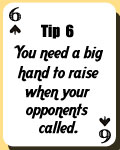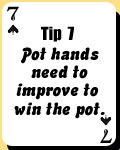You need a big hand to raise when your opponents called.
Though you would have preferred to get some action when you would pick up a monster (an extremely good hand for a particular situation) such as a pair of aces or kings, one of the inducements for raising  when you had entered a pot would have been the likelihood that you might have simply won the blinds right away.
when you had entered a pot would have been the likelihood that you might have simply won the blinds right away.
Still, this would not have been the case when one or more poker players would have entered the pot before the action would get to you. Since other poker players would have shown eagerness to compete for the pot, you would have required a very good hand to raise.
Some understanding of your rivals would have been useful here. If you had paid attention when you sat in a game to what types of hands your rivals were turning over, you would have ascertained their opening requirements. (Also you should have studied their position when they had entered a pot.)
You might not even have required to see their hands; if a poker player had called eighty percent of the hands before the flop, he was likely to show you just about anything. On the other hand, alarm bells should have sounded in your head if another poker player had entered his first hand since you had sat down – hours ago. These types of playing methods would have definitely influenced whether some of your hands had merited a raise.
In general, when a typical poker player had called in front of you, you had needed a hand such as a pair of jacks, an ace and king, or an ace and queen suited to raise. When a number of poker players were in, you should have lifted your standards even more. Raised with a pair of queens or an ace and king suited.
If one loose poker player had called, you could have raised with some more hands, such as a pair of nines, an ace and queen or a king and queen suited. If the one caller had been remarkably solid, these hands would only have been worth a call, however, and raises should have been limited to a pair of jacks, an ace and king or an ace and queen suited.
Pot hands need to improve to win the pot.
As in Tip six, some hands had been lucrative to play, but shouldn’t have been played for a raise. This might have appeared to challenge the tight-aggressive style being advocated here.  Nonetheless, this had not necessarily been the case. When you made a raise in holdem poker, you should have had clear objective. Basically, raises have been made for one of two reasons. The first had been to reduce poker players, and the second had been to boost the size of the pot due to the strength of your hand.
Nonetheless, this had not necessarily been the case. When you made a raise in holdem poker, you should have had clear objective. Basically, raises have been made for one of two reasons. The first had been to reduce poker players, and the second had been to boost the size of the pot due to the strength of your hand.
When poker players had already called the opening bet, your raise would not have achieved the first objective. It may have cut down on the number of extra poker players to enter the hand, but if several poker players had already called, you would have still been facing a multiway situation. Thus, should you have chosen to raise, you would not have been doing it for the purpose of reducing poker players.
So, with poker players already in the pot, the main reason for you to have raised had been to increase the size of the pot due to the strength of your hand. Few hands would have been strong enough to merit a raise here. These hands have been reviewed in Tip six.
Calling would have been correct with hands that played well against many poker players. Mostly, these hands had included medium pairs from fives to tens, and big suited cards such as a king and queen or an ace and jack. The reason why you shouldn’t have raised with these hands would have been that they would have needed to advance to win. For the big suited cards, you would have needed to flop a pair, straight draw, or flush draw to carry on with the hand.
For the pairs, you would have needed to flop a set (three of a kind), although flops such as two twos and a five would have often been good enough for a hand such as a pair of nines when four of five poker players would have been in the pot. So, by just calling preflop, you would have been able to make a smallest opening investment, having allowed you to discard your hand swiftly and effortlessly when the flop would have missed you.
Conversely, had you caught a nice flop, you could have now gone into an offensive mode. Basically, with these types of hands in multiway situations, you would have been saving your tight-aggressive play until after the flop, when you would have had more data.
Sometimes you would be sitting in late position holding a decent hand when five or more poker players had limped in. How should these family pots (those with multiple poker players) have influenced your starting requirements? First, you should have remembered that with so many partakers, it would have probably required a better than average hand to end up winning the pot.
In two-way or three-way pots, hands such as top pair (one of your cards had matched the highest card on the board, such as an ace and nine and a flop of nine, four, two) would have be likely to get the job done. But in poker, top pair (even two aces) would typically not have been enough against more than five opponents.
So, you should have looked to play hands that would have had the potential to increase beyond just pair. Poker hands such as an ace and ten offsuit would have been almost useless in these situations, as they would have consisted little straight or flush potential. Instead, good hands would have included any pair and big connecting suited cards.
With a pair, you should have won a nice pot if you had flopped a set, as one of your many rivals would probably have paid you off when he would have held top pair. The hand ten and nine suited would have definitely been playable here, as it would have possessed a hand such as this, you couldn’t get excited when you flopped a pair, if several poker players had been involved. You would likely have been either out kicked or outdrawn, as a middle pair would have been particularly weak.
